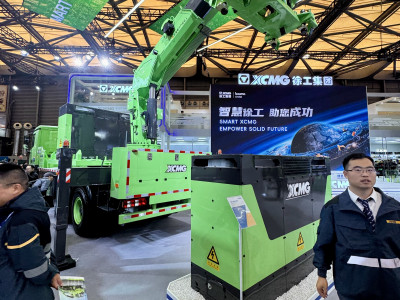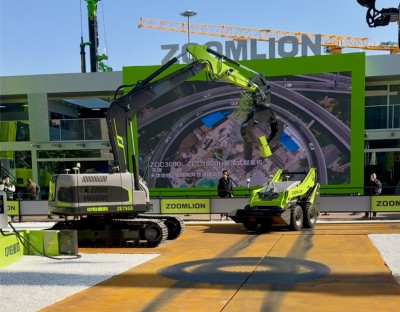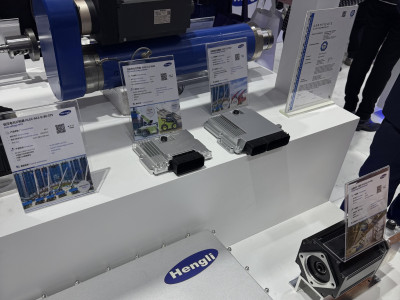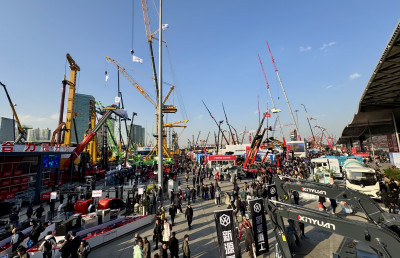During the last week of November, bauma China took place for the first time since 2020. Here are some of our major observations.
Challenging situation in the domestic market, increasing importance of exports
The domestic construction machinery market remains challenging. Last year, cumulative production volumes fell to less than two-thirds of their historical highs, and domestic sales accounted for less than half of the peak levels reached four years ago. While the downward trend has slowed this year, a recovery remains uncertain due to the ongoing crisis in the Chinese real estate sector.
Conversely, leading Chinese manufacturers are playing an increasingly prominent role in the global market. The share of exports in total revenue has steadily increased in recent years. In the first half of 2024, companies such as Sany, Zoomlion, and XCMG recorded export shares of 62.2%, 49.1%, and 45.7%, respectively.
This trend was also reflected in the large number of foreign visitors at the event. Similar to other industries, China is establishing itself as the premier location for hosting Asia’s most important trade shows. According to the organizers, this was the largest bauma China to date, with 700 exhibitors on the waitlist.
While lawmakers in Europe rely on moral arguments and regulatory measures to drive the transition to electrified construction machinery, this shift is already underway in China – driven primarily by economic reasons.
Rapid strides towards electrification
Much like the automotive industry, China is taking a leading role in the electrification of construction machinery. While less than 1% of construction machinery sold in Europe is electrified, in China, this figure is already around 7% and could quickly rise into double digits. Chinese OEMs are capitalizing on the supply chain that has evolved around electric vehicles over the past 15 years. Both BYD and CATL presented several new batteries specifically for the use in heavy machinery.
Unlike in Europe or California, where political regulations are the primary drivers, in China, economic considerations are the key motivators for customers to purchase electrified construction machinery. An electric wheel loader with a 5-6 ton payload costs 60-100% more than a diesel-engine loader. However, due to low electricity prices, the operating costs are so low that payback is typically achieved within 7-18 months.
For some European visitors who had not been to China for a while, the significant presence of electric machines came as a shock.

However, not all machine types are being electrified at the same rate. For example, while some manufacturers report that 40 percent of wheel loaders sold were electric, the share of electric excavators remains around 1%.
Another area of focus for new energy heavy vehicles is mining and port machinery. During bauma China, XCMG secured a landmark USD 400 million contract to supply more than 100 zero-emissions mining machines to Australian iron ore miner Fortescue. This deal is XCMG’s largest overseas mining equipment contract and includes the delivery of battery-electric wheel loaders, dozers, water carts, float prime movers, and graders to Fortescue’s Pilbara operations by 2030. The company further announced that new energy products now account for 18% of its revenue.
All major players also showcased some hydrogen-powered prototypes.


Smart functions advancing slowly
China is also making headlines with cutting-edge pilot projects in autonomous machinery. At the end of September, a consortium led by Hubei Communications Investment announced that it had largely autonomously paved a 157 km section of the Beijing-Hong Kong highway using Sany road construction machines guided by satellite navigation and drones.
XCMG presented their unmanned road rollers in action, reporting that 4,000 km have already been paved using this technology.
Zoomlion exhibited their remote-control solutions, focusing initially on earth-moving machines and cranes at a later stage. The company furthermore showed three unmanned machines demonstrating collaborative workflows.

Even fever foreign OEMs
In recent editions of bauma China, Japanese and Korean OEMs have increasingly been absent. This year, Volvo joined the list of companies skipping the event.
Caterpillar maintained a booth, as did John Deere’s Wirtgen Group and Bomag. It seems there is still demand for foreign expertise in road construction and recycling technologies.
Foreign companies must become faster and more innovative again
“Speed is crucial to succeed,” remarked the Chinese board member of a German drive technology company.
Whereas foreign component suppliers still benefit from their global sales and service networks, many of them lag when it comes to integrating electronics into their solutions.
Development cycles in China are significantly shorter, and costs are usually lower than in Western markets. Many Chinese firms in the field hope to leverage the current transformation to leapfrog, just as their peers in electric cars have already done successfully.






